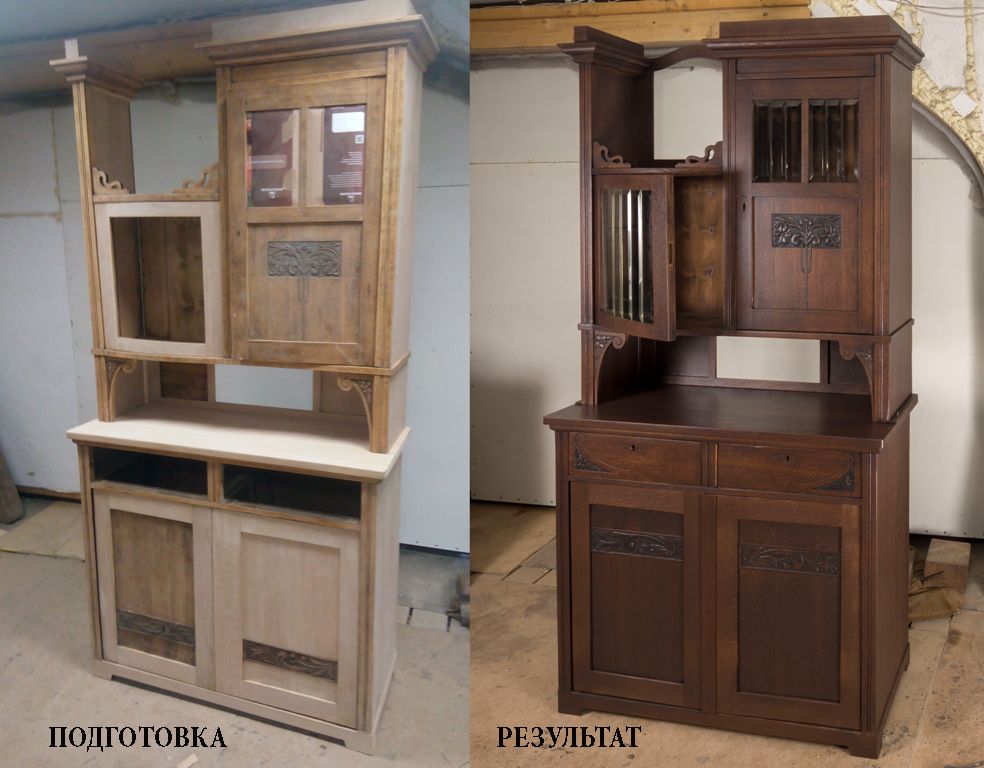DIY wooden buffet
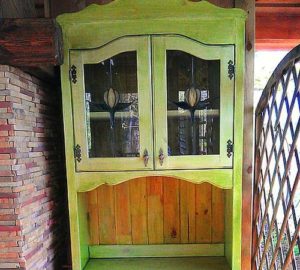 The kitchen is one of the most important rooms in any residential home. For greater convenience, you can place a kitchen cabinet or buffet in it, including one made by yourself. A sideboard is a cabinet with shelves and a closed lower compartment; it is not just another set of additional shelves, but a whole design and practical solution for the kitchen. The modern market offers many options for buffets to choose from, but it is still difficult to choose the right size and suitable design, so kitchen cupboards are often assembled with your own hands.
The kitchen is one of the most important rooms in any residential home. For greater convenience, you can place a kitchen cabinet or buffet in it, including one made by yourself. A sideboard is a cabinet with shelves and a closed lower compartment; it is not just another set of additional shelves, but a whole design and practical solution for the kitchen. The modern market offers many options for buffets to choose from, but it is still difficult to choose the right size and suitable design, so kitchen cupboards are often assembled with your own hands.
The content of the article
How to make a wooden buffet with your own hands
Such functional furniture stands out among purchased ones: you have the opportunity to choose the material and texture yourself, choose the right color, design and look, and make a sideboard that is ideal and fits into the overall style of the kitchen. Another advantage is the ability to make a buffet that fits perfectly in size, while purchased furniture cannot offer a variety of sizes.
Important! To decorate a new sideboard, you can use various styles: painting in an unusual color, modeling, unusual glass. For the upper open part, it is better to choose beautiful dishes, and hide pots and pans in the lower drawer.
The buffet will fit well into any interior.It can be an antique sideboard, with carvings and made of real wood, or modern sideboards in a strict and laconic form.
Materials and tools
The variety of modern building materials allows you to choose any convenient material, based on financial capabilities and personal preferences. The most popular ones in our work are:
Fiberboard
The material is resistant to high humidity, durable, affordable and relatively easy to process. Mainly used for the back walls of cabinets, wall cabinets and drawers, without deformation and securely held on fasteners. The simplicity of this material allows you to experiment with it, and its lightness allows you to reduce the weight of the finished buffet.
Chipboard
Comfortable material with a variety of patterns on the surface is widely used for making furniture. It is quite durable, lightweight and easy to work with, strong and, thanks to its structure, repels water. It is easy to work with, it holds the cut shape well and is convenient when cutting and assembling, holding nails well. However, finished furniture should not be installed near heat sources. Otherwise, the release of harmful substances from the compressed resin into the air can lead to allergies and diseases.
MDF
The widespread use of this environmentally friendly material is due to its advantages: moisture resistance, beautiful structure. The principle of its creation is similar to chipboard, but it is made from higher quality materials and is not afraid of being near heat. The only drawback is the relatively high price. MDF holds its shape well and can be used to create decorative elements.
Wood massif
An ideal material for creating such furniture.It is environmentally friendly, and the properties can vary due to the choice of different types of wood, which also differ in physical properties. Pine, larch or oak are best suited for a buffet. Natural wood looks much better, but the cost will be comparatively higher. To save money, you can assemble a sideboard using various materials and use wood for the front parts, and create shelves and the back wall from cheaper analogues.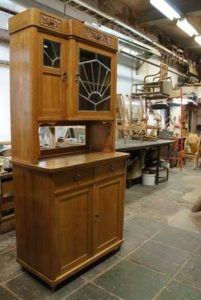
In addition to the material for cutting, you will need a set of tools. There are no special mechanisms or devices here; everyone can find them:
- drill;
- screwdriver;
- wood drills;
- roulette;
- duct tape;
- pencil for drawing;
- vice;
- Grinder;
- milling machine;
- sanded sheet;
- varnish coating;
- drawing.
The drawing is prepared in advance and contains all the necessary dimensions, number of units, thickness of all materials and their quantity. The drawing allows you to calculate everything in advance and purchase the required number of sheets and cuts.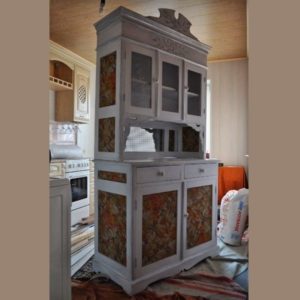
How to take measurements correctly
To ensure that upon completion of the work there are no excess materials left or, on the contrary, a shortage is not discovered, all necessary measurements and initial calculations are carried out before work. To do this, use a drawing calculating the height and width of the product and all elements: shelves, doors, etc.
- Sketching a kitchen wall or corner on a sheet of paper will always allow you to keep before your eyes an image that can be considered three-dimensional. It is also necessary to sketch out all the elements located there: sockets, pipes, other furniture that cannot be moved.
- Carefully measure all possible distances and record them in the drawing: the ceiling may not be perfectly flat, so height measurements must be taken in at least two places. The desired depth of the chest of drawers is noted with additional consideration for the thickness of the doors and back wall. The height of the chest of drawers should take into account the fact that when installing it, it will be necessary to raise it and not damage the ceiling.
- At this stage, the calculation of the opening of the doors, the dimensions of the protruding parts of the decoration and the height of the chest of drawers are carried out. Control measurements of the chest of drawers are applied to the drawing and a general check is made: the chest of drawers must take into account the height of the ceiling, should not cover the window and, when using chipboard, should not be located next to the radiator.
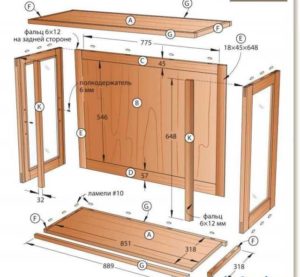
Important! Measurements should be recorded in millimeters.
Buffet yourself: step-by-step instructions
After taking all the necessary measurements and cutting, the buffet is assembled in the following order:
- Preparation of large elements: marking the side walls, rear wall, bottom, etc. At this point, all parameters according to the drawing are taken into account.
- Preparing smaller parts of the sideboard, preparing side parts for fastening, holes for assembly, connecting partitions and main parts using fasteners.
- Mounting the housing and installing the internal parts using screws and angles, assembling the base parts according to the drawing.
- Placement of the façade slab with projections for the doors and back panel.
- The back wall is assembled, the canvas is fixed at the back and for convenience the finished buffet can be laid on its side.
- Installation of hanging parts: hinges, doors, additional design elements.
- Installing furniture in its place and checking the overall assembly for quality of installation.
- Decoration: installation of door handles, coating or decoupage.
Important! Professionals advise using a depth limiter, this will prevent you from damaging the wall by drilling through it.

Important! For convenience and to avoid errors, it is recommended to number and mark the parts.
Assembling a buffet at home is not as difficult as it might seem at first glance. Careful measurements, selection of materials and arrangement of the workplace will help you create a homemade piece of furniture that fits perfectly into the interior.




